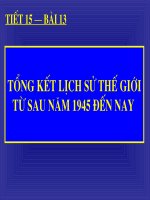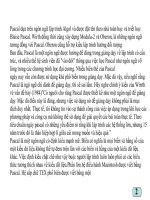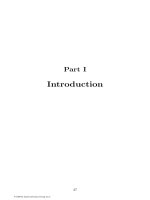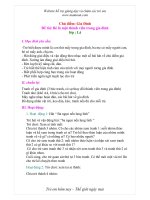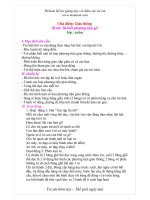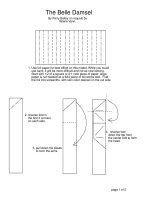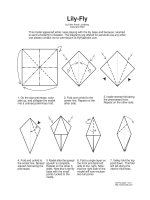Tài liệu Kira ppt
Bạn đang xem bản rút gọn của tài liệu. Xem và tải ngay bản đầy đủ của tài liệu tại đây (927.48 KB, 17 trang )
Brenda Hoddinott
C-07 BEGINNER: DRAW WITH LINES
This fun project takes you step by step through the
process of setting up proportional guidelines, and
drawing the facial features and hair, of a female
anime character named Kira.
If you choose to render this drawing completely in
pencil you need: good quality white drawing
paper, graphite pencils, kneaded and vinyl erasers,
pencil sharpener, sandpaper block, and a ruler. If
you plan to use a marker for the final version, you
will also need a fine tip permanent marker, and
you should use a drawing paper that is specifically
designed for drawing with markers, rather than
regular paper.
Mangas originated in Japan and are popular with artists of every age all over the world! The eyes
generally appear disproportionately large, and the nose and mouth tend to be drawn small and
simple so as to emphasize the powerful expressions of the eyes.
This project is divided into the following sections:
INTRODUCTION
SETTING UP FACIAL PROPORTIONS
SKETCHING KIRA’S FACE AND HAIR
THE PARTS OF AN EYE
DRAWING THE INDIVIDUAL FACIAL FEATURES
SKETCHING MORE DETAILED INFORMATION
ADDING FINAL TOUCHES WITH THIN NEAT LINES
This project is recommended for artists from age 10 to adult, as well as home schooling,
academic and recreational fine art educators.
17 PAGES – 28 ILLUSTRATIONS
Published by Hoddinott Fine Art Publishers, Halifax, NS, Canada – Revised 2006
Copyright to all articles, images, text, projects, lessons and exercises within this drawing class belong to Brenda Hoddinott and may
not be reproduced or used for any commercial purposes whatsoever without the written permission of Brenda Hoddinott.
Web sites and
- 2 -
INTRODUCTION
While Mangas originated in Japan, today these comic books, based on a unique genre of
cartooning, are popular with artists of every age all over the world! The overall proportions of
most manga adult faces closely resemble those of a young human child, giving the characters the
appearance of having a childlike head attached to a mature adult body.
The eyes generally appear disproportionately large, and are the most expressive part of the face.
The nose and mouth tend to be drawn small and simple so as to further emphasize the powerful
expressions of the eyes and the facial area around the eyes. Keep in mind that the term Manga
encompasses a vast array of individual styles, which allows artists to use their creative license in
the design of their characters’ faces, hairstyles, personalities, and clothing.
If you choose to render this drawing completely in pencil you need: good quality white drawing
paper, graphite pencils, kneaded and vinyl erasers, pencil sharpener, sandpaper block, and a
ruler. If you plan to use a marker for the final version, you will also need a fine tip permanent
marker, and you should use a drawing paper that is specifically designed for drawing with
markers, rather than regular paper.
GLOSSARY OF ART TERMS
Curved lines: are created when a straight line curves (or bends). Curved lines can be drawn
thick or thin.
Drawing: is the application of an art medium to a surface so as to produce a visual image, which
visually defines an artist’s choice of drawing subjects from his or her own unique perspective.
Form: as applied to drawing, is the illusion of the three-dimensional structure of a shape, such as
a circle, square or triangle, created in a drawing with shading and/or perspective.
Light source: is the direction from which a dominant light originates. The placement of this
light source affects every aspect of a drawing. The light source tells you where to draw all the
light values and shadows.
Proportion: is the relationship in size of one component of a drawing to another or others.
Shape: refers to the outward outline of a form. Basic shapes include circles, squares and
triangles.
Sketch: is a quick, rough representation or outline of a planned drawing subject. A sketch can
also be a completed work of art.
Symmetry: is balanced arrangement (sometimes referred to as a mirror image) of lines and
shapes on opposite sides of an often-imaginary centerline.
Values: are the different shades of gray created when you draw by varying both the density of
the shading lines, and the pressure used in holding various pencils.
Copyright to all articles, images, text, projects, lessons and exercises within this drawing class belong to Brenda Hoddinott and may
not be reproduced or used for any commercial purposes whatsoever without the written permission of Brenda Hoddinott.
Web sites and
- 3 -
SETTING UP FACIAL PROPORTIONS
In this section, simple guidelines show you how to place Kira’s features on her face. Keep in
mind that the faces of many adult manga characters are similar to those of real life children.
I now take you step by step through the process of setting up proportional guidelines on a frontal
view of an adult female anime head in preparation for drawing facial features. Remember, you
can use these same guidelines for drawing tons of different anime characters.
1. Use a ruler to draw a straight line down the center of your page.
Use an HB pencil, and keep your line very light so it can be easily erased. This is a line of
symmetry and provides you with a guideline for drawing both sides of the head the same
size. You simply measure various horizontal distances on either side of the center line.
2. Lightly sketch an egg-shape with the small end at the bottom of your drawing space.
Use your line of symmetry to make sure both sides are approximately the same size.
3. Refine your egg-shape so it more closely resembles the shape of a human head.
ILLUSTRATION 07-01 ILLUSTRATION 07-02
Copyright to all articles, images, text, projects, lessons and exercises within this drawing class belong to Brenda Hoddinott and may
not be reproduced or used for any commercial purposes whatsoever without the written permission of Brenda Hoddinott.
Web sites and
- 4 -
4. Measure the distance from the top of the head to the chin along your line of
symmetry.
5. Divide this distance in half and mark this point on the line of symmetry.
6. Draw a horizontal line through the point.
Remember to keep your line very light by applying very little pressure to your pencil as
you draw. This line marks the placement of the tops of the eyes.
7. Measure the distance between the horizontal line and the bottom of the chin, divide
this distance in half, and mark it with a dot.
8. Draw a second horizontal line through this point.
This line marks the location of the lowest section of the tip of the nose. The mouth will be
drawn below it.
ILLUSTRATION 07-03 ILLUSTRATION 07-04
Copyright to all articles, images, text, projects, lessons and exercises within this drawing class belong to Brenda Hoddinott and may
not be reproduced or used for any commercial purposes whatsoever without the written permission of Brenda Hoddinott.
Web sites and
- 5 -
SKETCHING KIRA’S FACE AND HAIR
It’s now time to use the proportional guidelines to begin sketching Kira’s facial features and hair
in their correct places.
9. Measure the distance from the vertical line of symmetry to each outer edge of the
head along the upper horizontal line.
10. Mark each point with a dot (or a tiny vertical line).
These two dots mark the vertical centers of the eyes. Now you know both the position of
the top of each eye (the upper horizontal line), and where the center of each eye will be.
11. Lightly sketch two circular shapes to represent the eyes.
Observe that the bottom of each eye ends approximately halfway between the two
horizontal lines. Also note that the distance between the eyes is slightly more than the
width of an eye.
ILLUSTRATION 07-05 ILLUSTRATION 07-06
With lots of practice in drawing manga faces, you won’t need to draw the
proportional lines with a ruler. You’ll be able to simply eyeball the lines
and distances in your mind.
Copyright to all articles, images, text, projects, lessons and exercises within this drawing class belong to Brenda Hoddinott and may
not be reproduced or used for any commercial purposes whatsoever without the written permission of Brenda Hoddinott.
Web sites and
- 6 -
ILLUSTRATION 07-07
12. Sketch in a tiny curved line slightly
above the lower horizontal line to
represent the lower tip of the nose.
13. Add a line almost halfway down
from the lower horizontal line.
This line marks the placement of the
lower edge of the bottom lip.
ILLUSTRATION 07-08
14. Draw Kira’s ears (or ear).
You only need to draw the one on the
right because the other will be hidden
under her hair. Take note that the
upper edges of the ears touch the upper
horizontal line, and the bottoms touch
the lower one.
15. Carefully erase the guidelines
including the line of symmetry.
You may need to redraw a few
sections that are accidentally erased.
Drawing a realistic circle freehand becomes quite simple when you’ve
devoted lots of time to practicing this skill. A couple of helpful hints include:
1. Try rotating your paper and looking at your drawing from different
perspectives. This little trick often allows you insight into the problem
areas.
2. Looking at the reflection of your circle in a mirror will also help you to
see areas in need of fixing.
Copyright to all articles, images, text, projects, lessons and exercises within this drawing class belong to Brenda Hoddinott and may
not be reproduced or used for any commercial purposes whatsoever without the written permission of Brenda Hoddinott.
Web sites and
- 7 -
ILLUSTRATION 07-09
16. Sketch in the various strands of hair
around her face.
Refer to Illustration 07-09 and Observe
the following before you begin to draw:
a. The lines are all curved even though
her hair looks straight.
b. All sections of hair end in a sharp
point.
c. The strand on the left side of her
head is longer than the one on the
right.
d. The longest section of her bangs is
right in the middle and the lines
curve toward the left.
ILLUSTRATION 07-10
17. Use your vinyl eraser to erase
the sections of her ears that
appear to be hidden under
her hair.
18. Sketch the strands of hair
around the perimeter of her
head.
Take note of the distance of the
strands of hair from the
perimeter of her head to help
you draw your proportions
more accurately.
Copyright to all articles, images, text, projects, lessons and exercises within this drawing class belong to Brenda Hoddinott and may
not be reproduced or used for any commercial purposes whatsoever without the written permission of Brenda Hoddinott.
Web sites and
- 8 -
THE PARTS OF AN EYE
The same names that identify the various parts of realistic eyes are used for anime eyes. Refer to
the next drawing and become familiar with the terms used to identify each part of an eye:
1. The arch-shaped group of hairs, above the eye, is known as an eyebrow.
2. A fold in the skin, above the eye is called an upper eyelid crease.
3. The upper eyelid is a movable fold of skin that opens and closes to protect the eyeball.
4. A small triangular shape in the inside corner of the eye, is called the inner corner (rarely
drawn in manga art).
5. The white of the eye (the visible section of the eyeball) is light, but not really white.
6. A highlight is the brightest area where light bounces off the surface of the eye.
7. Eyelashes are fine hairs that grow from the outer edges of the upper and lower eyelids.
8. The pupil of an eye is the darkest circular shape within the iris.
9. The iris is the colored circular section of the eyeball surrounding the pupil.
10. The lower eyelid is a fold of skin protecting the lower section of the eyeball.
ILLUSTRATION 07-11
In the following sections you discover all the fun parts of this project. You first add more details
to Kira’s face and hair, and then outline your drawing with nice neat lines.
Copyright to all articles, images, text, projects, lessons and exercises within this drawing class belong to Brenda Hoddinott and may
not be reproduced or used for any commercial purposes whatsoever without the written permission of Brenda Hoddinott.
Web sites and
- 9 -
DRAWING THE INDIVIDUAL FACIAL FEATURES
The faces of adult anime cartoon characters are very similar to those of children. In this section,
simple guidelines show you how to draw Kira’s eyes according to manga style.
ILLUSTRATION 07-12
19. Sketch Kira’s
upper lip above
the line that
indicates the
location of her
mouth.
The line that marks
the mouth (step 13),
now becomes the
bottom of the lower
lip. Take note that
the width of her
mouth is the same
as the space
between her eyes.
ILLUSTRATION 07-13
20. Add a slightly
curved line along the
lower edge of the
two circles.
Note that the lines
extend beyond the eye
circles on both sides.
At this stage the
drawing looks like an
anime character with
her eyes closed.
However, in this
drawing these lines
indicate the edges of
the lower eyelids.
Copyright to all articles, images, text, projects, lessons and exercises within this drawing class belong to Brenda Hoddinott and may
not be reproduced or used for any commercial purposes whatsoever without the written permission of Brenda Hoddinott.
Web sites and
- 10 -
ILLUSTRATION 07-14
21. Add a curved line to the
upper section of each eye
to indicate the edges of
her upper eyelids.
These lines are longer than
those marking the edges of
her lower eyelids.
ILLUSTRATION 07-15
22. Add Kira’s eyebrows
above her eyes.
The eyebrows are shaped
like commas with the wider
ends pointed toward the
upper center section of her
forehead (hidden under the
hair).
ILLUSTRATION 07-16
23. Outline the irises of
Kira’s eyes.
Observe that a small
section of the top and
bottom of each iris seems to
be hidden under the upper
and lower eyelids.
24. Slightly extend the lines
marking the upper eyelids
toward the center of her
face and downward.
Copyright to all articles, images, text, projects, lessons and exercises within this drawing class belong to Brenda Hoddinott and may
not be reproduced or used for any commercial purposes whatsoever without the written permission of Brenda Hoddinott.
Web sites and
- 11 -
ILLUSTRATION 07-17
25. Add a smaller circle
inside each iris to
represent the pupils of the
eyes.
Observe that a small
section on the upper left of
each pupil is a short straight
line rather than a
continuation of the circle.
SKETCHING MORE DETAILED INFORMATION
Anime cartoons tend to be rendered with thin neat lines. Keep a pencil sharpener and sandpaper
block handy so you can easily keep your pencil points nice and sharp.
ILLUSTRATION 07-18
26. Use your kneaded eraser to
lighten all the lines that define
the hair until you can barely see
them.
27. Use a very sharp pencil to outline
each strand with neat crisp lines.
You may need to re-sharpen your
pencil several times as your work
to keep the lines thin and neat.
If you plan to later use a fine tip
marker to outline Kira, use a 2H
pencil.
Should you prefer to finish your
drawing in pencil rather than pen,
consider using a freshly sharpened
2B pencil. You may want to use a
sandpaper block to keep the point
very sharp.
Copyright to all articles, images, text, projects, lessons and exercises within this drawing class belong to Brenda Hoddinott and may
not be reproduced or used for any commercial purposes whatsoever without the written permission of Brenda Hoddinott.
Web sites and
- 12 -
ILLUSTRATION 07-19
28. Use your kneaded eraser
to lighten all the lines of
her facial features, ear,
and the outline of her
face.
29. Redraw each section with
thin neat lines.
ILLUSTRATION 07-20
30. Draw a U-shaped line in
the upper left section of
each iris.
The circular shapes created
when you add these lines
are referred to as highlights.
In that these highlights are
more on the left than the
right, we can safely assume
that the dominant light
source is coming from the
left.
Copyright to all articles, images, text, projects, lessons and exercises within this drawing class belong to Brenda Hoddinott and may
not be reproduced or used for any commercial purposes whatsoever without the written permission of Brenda Hoddinott.
Web sites and
- 13 -
ADDING FINAL TOUCHES WITH THIN NEAT LINES
The final lines can be drawn with either pencil or a very fine tip black marker. In this section you
will complete your drawing using either of the following methods:
If you are working in pencil, add the details of the eyes and tidy up any untidy lines. Keep
your pencil points nice and sharp.
If you are planning to use a marker, first lighten all your pencil lines until you can barely see
them. Then you take your time and slowly and carefully redraw each line.
ILLUSTRATION 07-21
31. Check over the upper face
and change or modify any
sections you are not
happy with.
32. Add final touches so your
lines are all neat.
ILLUSTRATION 07-22
33. Add a slightly curved line
above each eye to
represent the upper eyelid
creases.
ILLUSTRATION 07-23
34. Fill in the pupils of the
eyes.
If you are using pencil use
a 4B or 6B.
Copyright to all articles, images, text, projects, lessons and exercises within this drawing class belong to Brenda Hoddinott and may
not be reproduced or used for any commercial purposes whatsoever without the written permission of Brenda Hoddinott.
Web sites and
- 14 -
ILLUSTRATION 07-24
35. Fill in the upper section of
each iris around the
pupil.
ILLUSTRATION 07-25
36. Add some eyelashes along
the upper and lower
eyelids.
ILLUSTRATION 07-26
37. Add some lines extending
from the pupil outward to
the edge of the iris in the
upper sections.
These lines help make the
eyes appear more realistic.
Copyright to all articles, images, text, projects, lessons and exercises within this drawing class belong to Brenda Hoddinott and may
not be reproduced or used for any commercial purposes whatsoever without the written permission of Brenda Hoddinott.
Web sites and
- 15 -
38. Finish outlining all other sections of your drawing.
ILLUSTRATION 07-27
Sign your name, put the
date on the back of your
drawing paper, pat
yourself on the head,
give yourself a big hug
and choose another
drawing project!
Copyright to all articles, images, text, projects, lessons and exercises within this drawing class belong to Brenda Hoddinott and may
not be reproduced or used for any commercial purposes whatsoever without the written permission of Brenda Hoddinott.
Web sites and
- 16 -
Of course, if you want to add color to your drawing, you have
many options such as markers or colored pencils. You can even
bring your image into a computer program and add colors.
The drawing below was colored with Adobe Photoshop.
ILLUSTRATION 07-28
Copyright to all articles, images, text, projects, lessons and exercises within this drawing class belong to Brenda Hoddinott and may
not be reproduced or used for any commercial purposes whatsoever without the written permission of Brenda Hoddinott.
Web sites and
- 17 -
BRENDA HODDINOTT - BIOGRAPHY
As a self-educated teacher, visual artist, portraitist, forensic artist, and illustrator, Brenda
Hoddinott utilizes diverse art media including graphite, technical pen, colored pencil, chalk
pastel, charcoal, conté crayon, and oil paints.
My philosophy on teaching art is to focus primarily on the
enjoyment aspects while gently introducing the technical and
academic. Hence, in creating a passion for the subject matter,
the quest for knowledge also becomes enjoyable.
>Brenda Hoddinott<
Born in St. John’s, Newfoundland, Brenda grew up in the small town of Corner Brook. She
developed strong technical competencies with a personal commitment to self directed learning,
and the aid of assorted “Learn to Draw” books. During Brenda’s twenty-five year career as a
self-educated civilian forensic artist, numerous criminal investigation departments have
employed Brenda’s skills, including Royal Canadian Mounted Police and municipal police
departments. In 1992, Brenda was honored with a commendation from the Royal Canadian
Mounted Police, and in 1994, she was awarded a Certificate of Membership from “Forensic
Artists International”.
Her home-based art career included graphic design, and teaching recreational drawing and
painting classes. As supervisor of her community’s recreational art department, Brenda hired and
trained teachers, and designed curriculum for several children’s art programs. In 1998, Brenda
chose to end her eighteen-year career as an art educator in order to devote more time to writing,
drawing, painting, and developing her websites.
Drawspace
incorporates her unique style and innovative approach to
curriculum development. This site offers downloadable and printable drawing classes for
students of all abilities from the age of eight through adult. Students of all ages, levels and
abilities have praised the simple step-by-step instructional approach. This site is respected as a
resource for fine art educators, home schooling programs, and educational facilities throughout
the world.
LEARN-TO-DRAW BOOKS BY BRENDA HODDINOTT
Drawing for Dummies (2003): Wiley Publishing, Inc., New, York, NY, this 336 page book
is available on various websites and in major bookstores internationally.
The Complete Idiot’s Guide to Drawing People (2004): Winner of the Alpha-Penguin
Book of the Year Award 2004, Alpha - Pearson Education – Macmillan, Indianapolis, IN,
this 360 page book is available on various websites and in major bookstores internationally.
